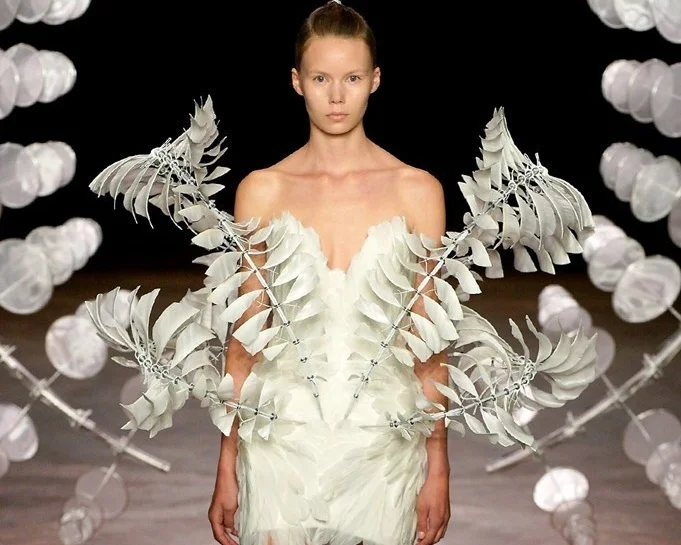Fall 2024 Haute Couture: Iris van Herpen's Hybrid Show
In the midst of assembling 16 years’ worth of boundary-pushing Couture for her Musée des Arts Décoratifs retrospective, Iris van Herpen realized there was another creative ambition she had yet to fulfill. “I could see the interdisciplinary approach throughout my whole body of work, but I was missing something that had always been a part of me: my love of sculpture and painting,” says van Herpen, who although known for her classical dance background, grew up simultaneously entrenched in visual art.
On June 24 during Paris Haute Couture Week, van Herpen presented her signature spellbinding Couture alongside her first aerial sculptures, ushering in a new era of visual artistry for the maison.
“For a long time I’ve been working on expanding people’s perception of how fashion and art can be symbiotic. This is the natural next step for me to really show what I mean,’ she says, likening her preferred process of moulage, or draping directly on the mannequin, to sculpting. “Even though we call one practice ‘Haute Couture’ and the other ‘art,’ to me, it’s one universe.”
Conceived as two pairs, the four large-scale artworks (below) feature an array of innovative techniques on tulle surfaces, suspended and stretched via steel tubes. Tulle, a favored material synonymous with classical ballet costumes, also serves as the basis for most of van Herpen’s Couture looks.
A year in the making, van Herpen’s sculptures not only celebrate her reconnection with nature, but also the immense freedom she has gained from slowing down. With Unfolding Time, curvaceous, hand-pleated silk forms recall van Herpen’s sensation of time being stretched when outdoors. The two largest sculptures—Weightlessness of the Unknown and Embers of the Mind—embody how for van Her pen, the creative process parallels the rhythms within nature. Calling the works “self-portraits of her inner world,” van Herpen materializes the beauty and chaos of ideation and experimentation through ambiguous depictions of renewal and destruction. “The works are about catharsis,” says van Herpen who experiences the handwork as meditative. “It’s in that stage of surrendering to the craftsmanship, in being free from time, where I can let go of a certain physical reality that is constraining me and a sense of transcendence is materialized.”
Fragments of painted silk hand-stitched to the tulle base, invisible from afar, comprise cyclonic compositions; up close, lava-like textures have been achieved through tens of layers of oil paint, evoking the heavy impasto of Japanese artist Kazuo Shiraga’s gestural paintings. The impossibly floating forms capture the spirit of Abstract Expressionists like Joan Mitchell and the eerie, otherworldly mood of Hieronymus Bosch, who, born in the same Netherlands region as van Herpen, has left an everlasting imprint on her imagination.
The couturier additionally considers Louise Bourgeois an important influence due to her idiosyncratic approach to craftsmanship and the variety of her artistic output. The product of two parents who ran a tapestry restoration business, Bourgeois frequently infused textiles into her sculptures.
While the artworks celebrate nature’s awe-inspiring power, the hybrid presentation urges audiences to reconsider their own relationship with the planet.
Alongside the sculptures, performers are presented as living artworks, which are elevated and partially sculpted into their own canvases to reflect mankind’s perceived superiority.
Whether through gravity-defying silhouettes or ethereal draping that catches the air, van Herpen’s Couture-looks, too, seem to have a life of their own. While 3D-printing and the folding of silks are in the maison’s DNA, new techniques are showcased. The Umwelt and Aeromorphosis gowns, for example, feature a subtle gradient of pearls echoing the sculptures’ cyclonic compositions, while the transparent Ataraxy gown, sculpted with a heat gun, emulates the artworks’ floating quality. Like Unfolding Time and Ancient Ancestors, the white Ecosophy gown fuses organza with intricate 3D-printing that seamlessly transitions into lace. Van Herpen honors Japanese craftsmanship, precision, and spirituality of daily life with the Sensorium dress, composed of obi fabric from the couturier’s kimono collection.
By presenting the Couture looks and sculptures concurrently as artworks, as opposed to the typical frenetic runway, van Herpen suggests that the audience choose their own paths and spend more time appreciating the artistry and craftsmanship. “These looks took many months to make, so the importance of slowing down is not only present in the work itself but also in how people perceive them,” she says.






























